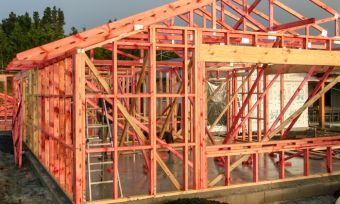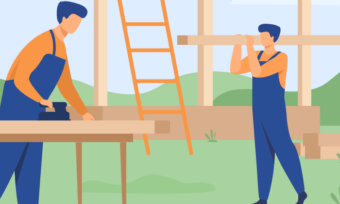1. Build to your section
The key to good home design is to build to the section, not the other way around. You should design or choose a house plan that is going to make the most of the site’s best attributes and minimise its worst features.
Working with what you’ve got will achieve the best possible outcome. This may mean integrating your home and garden into the existing site features. Consider the orientation of the home, and alter the plans to meet the slope of the section to reduce earthworks. And work in the positioning of a rainwater tank and any other external features on your wish list.
2. Plan ahead
All new builds require a huge amount of planning and preparation, even before any contracts are signed. So plan ahead.
Also, do your research. The more you know, the more likely you are to make the right decisions.
Understand the stages of the building process. Read the fine print. Ask questions. Meet deadlines. And reply to queries promptly.
3. Spend money on the stuff that matters
Wherever possible, spend money on the things you can’t easily change later. This includes the materials you build your home from (the framing to the cladding), electrical, plumbing and glass, through to the roofing, insulation, and interior linings.
Fittings such as taps and home decor are easily altered at a later date with very little disruption to the home. However, you can’t change your framing, and it’s very difficult and expensive to change windows or roof coverings.
4. Sign a fixed-price contract
A fixed-price contract keeps the budget under control and ensures there are no surprises down the track. It allows you to know exactly what funds you have to come up with and when, and works perfectly for mortgage planning and the release of progress payments from the bank.
5. Stick to the plan
Any changes you make to your house plans during the build will cost extra. This can include fees for just asking for the change, as well as the extra cost of making the change.
By planning out the details of the build before you start – colours, taps, floor coverings, kitchen and bathroom layouts, for example – you can avoid unnecessary costs.
6. Choose your builder carefully
Where possible, choose your builder based on recommendations from other satisfied customers. Best practice is to research at least three builders. Meet with them personally, seek out testimonials from previous customers, and get all three to quote for the job.
7. Don’t forget about outdoor living
Kiwis love their outdoor living spaces. So it’s important to include these areas in the design of your home. Strategically placed alcoves, outdoor heating, pergolas, and sunshades are all options for the outdoor entertainer, and best included in your original design to ensure the best use of space.
8. Don’t try to project manage your own build
Project management is a skill that’s best left to the professionals. The time (and stress) saved by employing a project manager will, ultimately, outweigh any cost savings you may achieve by attempting a DIY approach.
9. Get your priorities straight
Building is about learning to compromise, especially if you want to stick to your budget. However, it doesn’t mean you have to give up everything on your wish list. Hold firm on the things that matter most to you.
10. Stick to your budget
Make a budget that includes everything. And that means everything: from the letterbox and clothesline, to the driveway and landscaping, through to window dressings and any new furniture you may require. Not being able to complete a project due to a lack of funds is frustrating and disappointing.
11. Make the rounds
Go to home and building shows. Check out showrooms for carpets, kitchens, bathrooms, etc. Learn about what you want and what’s available.
12. Position for the best sun
The orientation of your home on your section makes a huge difference to the comfort and warmth of your home. Always position your home so that you have maximum year-round sunshine.
In NZ, main living areas should face north. This includes lounges, dining rooms and master bedrooms. Windows should be sized and positioned to make the most of the sun.
However, be aware that too much sun on the western side can be detrimental in the middle of summer, as the house may overheat. South-facing windows should always be small to minimise heat loss.
13. Don’t forget about ventilation – it’s more important than you think
Home ventilation is one of the most important factors when building a healthy home. Modern homes are much more airtight than their predecessors, and problems associated with poor ventilation have become more prevalent.
Whether building or renovating, ventilation should be at the top of the list early on in the design process. Good design should maintain the balance between the need to introduce fresh air and the need to maintain comfortable internal temperatures.
14. Visit the build site as often as possible
Even if you’ve spent hours working over the plans and measuring things to the millimetre, you will spot things that aren’t quite right when the build begins to take shape.
These can be things that have been interpreted differently by builders, plumbers or electricians, details not noticeable on the plans, or simply mistakes.
As the homeowner, you’re the one most invested in getting the build right. Picking up any discrepancies early on in the build can save a lot of time and money.
If you’re currently considering a home loan, the table below displays some of the 2-year fixed-rate home loans on our database (some may have links to lenders’ websites) that are available for home owners looking to refinance. This table is sorted by Star Rating (highest to lowest), followed by company name (alphabetical). Products shown are principal and interest home loans available for a loan amount of $500K in Auckland. Before committing to a particular home loan product, check upfront with your lender and read the applicable loan documentation to confirm whether the terms of the loan meet your needs and repayment capacity. Use Canstar’s home loan selector to view a wider range of home loan products. Canstar may earn a fee for referrals.
About the author of this page
This report was written by Canstar’s Editor, Bruce Pitchers. Bruce has three decades’ experience as a journalist and has worked for major media companies in the UK and Australasia, including ACP, Bauer Media Group, Fairfax, Pacific Magazines, News Corp and TVNZ. Prior to Canstar, he worked as a freelancer, including for The Australian Financial Review, the NZ Financial Markets Authority, and for real estate companies on both sides of the Tasman.
Enjoy reading this article?
You can like us on Facebook and get social, or sign up to receive more news like this straight to your inbox.
By subscribing you agree to the Canstar Privacy Policy
Enjoy reading this article?
You can like us on Facebook and get social, or sign up to receive more news like this straight to your inbox.
By subscribing you agree to the Canstar Privacy Policy





Share this article